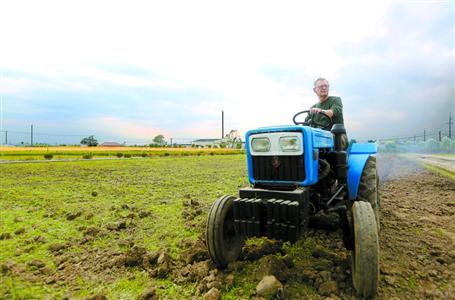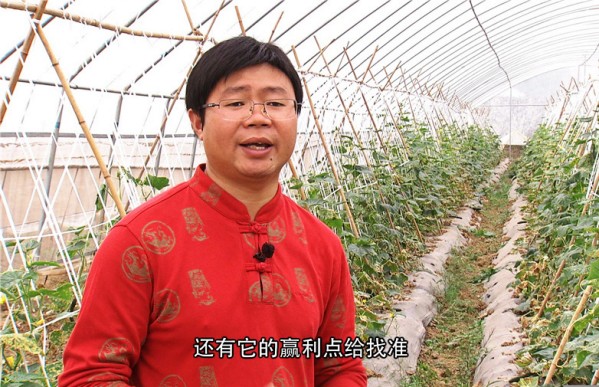Lang Jieshi, a cabbage farmer in Shanghai: the secret of a bumper harvest is hidden in the soil.

In 1992, Langes, an American, began to contract and manage farms on the outskirts of Shanghai, introducing more than 500 kinds of new European and American vegetables, and became the first "vegetable farmer" in Shanghai to engage in vegetable cultivation research. A few years ago, he was specially hired as a senior consultant by the Songjiang District Committee of Agriculture. "to grow the best vegetables with the lowest chemical cost while protecting the local soil and water environment" is Langes' planting philosophy.
"the secret of a bumper harvest lies deep in the soil." As soon as he sat down for a while, Langes, the "vegetable farmer", solemnly handed a small note to the reporter, which wrote this sentence in English.
Langes, from the United States, is a famous "vegetable farmer" in Shanghai. He has been engaged in vegetable cultivation research in Shanghai for more than 20 years, introducing more than 500 kinds of new European and American vegetables, and his farm vividly deduces the sample of ecological high-end agriculture with an almost stingy saving model. Not long ago, the 71-year-old Langes also won the 2015 Shanghai Magnolia Memorial Award.
Lao Lang is now unable to operate a farm of two to three hundred mu, and spends most of his time at home at the foot of Sheshan, writing memoirs of agricultural practice in China. He has been keeping a close eye on agriculture and farmers in Shanghai, renewing a few acres of land, conducting soil experiments on growing vegetables, and sometimes driving tractors to plough the fields.
In recent years, the ecological function of agriculture in Shanghai has become more and more prominent, and more and more attention has been paid to the protection of water, soil and gas. Farmers have also been more scientifically organized to set up family farms of a moderate scale and get more decent returns. It was hard for me to think of before. " Langes said that with the guidance of scientific ideas, agriculture and farmers will not be marginalized, but will become more and more promising.
In 1988, Langes came to China to promote fertilizer because of business, and began to cooperate with Shanghai soil Fertilizer Station to carry out soil experiments.
At that time, the nutrients of nitrogen, phosphorus and potassium in the soil in the suburbs of Shanghai were extremely uneven, so the yield of crops could not be effectively increased. Later, farmers gradually realized the importance of nitrogen and potash fertilizer, and overapplied it, causing damage to the soil again. In 1992, Langes began to practice farming in Pudong, exploring how to repair and balance the soil. For a long time, he was a lonely demonstrator.
Now, he is pleased to see that the surrounding farmers have begun to take care of the soil. Throughout Songjiang District, the "three-three system" has become an agricultural system: every year, 1/3 of all grain fields grow crops, 1/3 grow green manure, and 1/3 rest and recuperate. The combination of land cultivation and land cultivation can not only increase the yield of grain, but also protect the soil from overdraft.
Langes' observation was confirmed by Sun Lei, director of the Municipal Committee of Agriculture. During the 12th five-year Plan period, Shanghai urban agriculture adheres to the development direction of green ecology, promotes the comprehensive utilization of agricultural waste, controls and reduces agricultural non-point source pollution, improves the rural ecological environment, and realizes the sustainable development of agriculture. Last year, the comprehensive utilization rate of agricultural waste in the city reached 91%, and straw burning was basically prohibited. In the functional orientation of urban modern agriculture in Shanghai, ecological function is ranked first, followed by production function, leisure function and so on.
The change of farmers, the main body of agricultural management, surprised Langes even more. As for the family farm model that Songjiang took the lead in exploring, he said with great delight: "to organize farmers in a scientific and orderly manner, each family will plant one or two hundred mu of grain fields, so that they will not only get a higher income return, but also pay more attention to land and agriculture."
Langes believes that a key to the family farm model is to train a new generation of farmers with skills, ideals and dedication, so that China's agriculture will have a sustainable development prospect.
Indeed, over the past five years, the industrial management level of agriculture in Shanghai has been continuously improved, and all kinds of new business entities have been emerging. By the end of last year, the number of household grain production farms in the city had reached 2787, the number of farmers' cooperatives with certain operational capacity reached 3192, and the number of leading enterprises in agricultural industrialization reached 386. Farmers' incomes are also "getting higher and higher." Last year, the per capita disposable income of rural residents in Shanghai reached 21192 yuan, an increase of 35 per cent over 2011. The real growth rate of the income of rural residents in Shanghai has been faster than that of urban residents for seven consecutive years.
Langes said that he hopes to stay in Shanghai and witness with his own eyes that China's agriculture, farmers and rural areas are becoming more and more beautiful.
Related
- A course of planting techniques and methods on how to grow carrots
- How to plant the latest tulips?
- Is it better to pick tea in the morning or in the afternoon? When is the best time for tea to be picked? what is the third or fifth tea?
- Launch Yuanxiao Happy combination Haocha + Tea Yuan healthy Taste
- Penghu Tourism "Fireworks 20 Parade with You"
- 2022 West Lake Happiness holds "Digital Revitalization Voucher" and draws iphone13 and laptop.
- Banqiao Fuzhou social houses are designed to change start-up combined with police elimination to create a safe and livable environment
- The convenient measure of "mechanical weeding" in Xinbei has been abused and the Agriculture Bureau has imposed heavy penalties on the illegal land consolidation.
- Changgeng University Joins Hands with Four Memory Factories to Rescue Memory Talent Shortage
- The list of Taiwan's top 100 MVP managers is listed by the Director-General of the Farmers' Association of Sanxia District.



